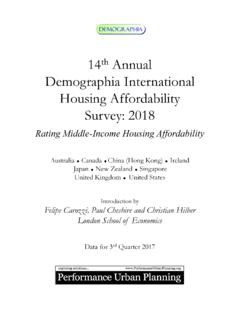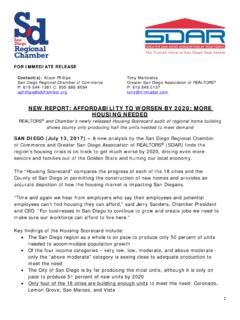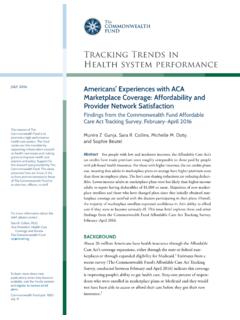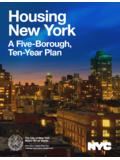Transcription of Affordability of Public Transport in Developing Countries
1 THE WORLD BANK GROUP WASHINGTON, Affordability of Public Transport in Developing Countries Robin Carruthers, Malise Dick and Anuja Saurkar Transport SECTOR BOARD Transport PAPERS TP-3 JANUARY 2005 2005 The International Bank for Reconstruction and Development/The World Bank 1818 H Street NW Washington, DC 20433 Telephone 202-473-1000 Internet The findings, interpretations, and conclusions expressed here are those of the author and do not necessarily reflect the views of the Board of Executive Directors of the World Bank or the governments they represent. The World Bank does not guarantee the accuracy of the data included in this work.
2 The boundaries, colors, denominations, and other information shown on any map in this work do not imply any judgment on the part of The World Bank concerning the legal status of any territory or the endorsement or acceptance of such boundaries. This paper has been produced with the financial assistance of a grant from TRISP, a partnership between the UK Department for International Development and the World Bank, for learning and sharing of knowledge in the fields of Transport and rural infrastructure services. To order additional copies of this publication, please send an e-mail to the Transport Help Desk Transport publications are available on-line at Affordability OF Public Transport IN Developing Countries iii TABLE OF CONTENTS 1 The Fundamental Paradox of Urban Transport 2 The Context of 3 Existing Information on Latin America in the Late Buenos Sao Belo Eastern United Kyrgyz Beijing and Nanjing, Wuhan.
3 African United 4 Construction of the Affordability Sample of Level of Quantity of Level of 5 Data used in construction of the Affordability Sample of Quantity of 6 Evidence From the Affordability Income Affordability Index for People on an Average 7 Affordability Index for People in the Bottom Quintile of the Income 8 Further Work on the Affordability City Income Passes and Changes in Fare Structures and Additional and Corrected Index Annex A Labor Mobility, Beneficiaries of Public Transport Services in Eastern Europe and Central Asia (ECA)..19 Annex B Urban Poverty and Transport : The Case of Annex C A Five Step Method to Calculate the Affordability Index for a Affordability OF Public Transport IN Developing Countries iv PREFACE The analysis reported here was prompted by a realization that there was little reliable and consistent information on what proportion of household income is spent on urban Public Transport .
4 The information available uses inconsistent definitions of what costs are included and how income is measured, making comparisons between cities difficult. To address the need for easily available and comprehensive comparative information on Affordability of Public Transport fares, we have developed an Affordability Index that is easy to measure and can be used as a first indication of the Affordability of fares in a particular city. The Index is computed for a person on an average income and for someone in the bottom quintile of the income distribution. In Developing this Index there has been no intention to indicate a proportion of income that is considered affordable as there are many additional factors than income that should be taken into account if such a proportion is to be suggested Technical Papers are published to communicate the results of The World Bank's work to the development community with the least possible delay.
5 The typescript manuscript of this paper therefore has not been prepared in accordance with the procedures appropriate to formally edited texts. Some sources cited in the paper may be informal documents that are not readily available. Affordability OF Public Transport IN Developing Countries 1 Affordability OF Public Transport IN Developing Countries 1 THE FUNDAMENTAL PARADOX OF URBAN Transport STRATEGY In 2002, the World Bank published Cities on the Move, an urban Transport strategy review that took a broader perspective than an earlier strategyi which had focused on economic and financial viability and less on the livability of the cities, which in turn depends on their being competitive, financially sustainable, well governed and well managed.
6 Cities on the Move has a strong focus on poverty. It concentrates on the problems of people who are very poor, not only in terms of their income but also in terms of the broader dimensions of social exclusion associated with inaccessibility to jobs, schools, health facilities and social activities. Cities on the Move identified three aspects of urban development that create a fundamental paradox of urban Transport strategy. (i) Urban Transport can contribute to poverty reduction both indirectly through its impact on the city economy and hence on economic growth, and directly through its impact on the daily needs of poor people.
7 But it exhibits a fundamental paradox. How can a sector with such an obvious excess of demand over supply, and with such a heavy involvement of private suppliers of service, fail so badly to meet the aspirations of politicians and citizens alike? Why has it not been possible to mobilize commercial initiative to yield the kind of revolution in service quality and cost which has been achieved in telecommunications, water and energy sectors? And why does increasing affluence seem to have the effect of reducing the quality of travel, at least for poor people? (ii) Urban growth increases Transport costs. From the viewpoint of efficiency and growth it is not too difficult to characterize the central problem.
8 Economies of agglomeration generate the growth of cities. As cities grow and become richer, vehicle ownership and use grow more rapidly than the available road space, resulting in increased congestion and traffic-generated air pollution. (iii) Urban growth often has perverse distributional effects. As cities expand, the price of more accessible land increases. Poor people are forced to live on less expensive land, either in slums or on the periphery of the city. As average incomes grow and car ownership increases, the patronage, financial viability, and eventually quality and quantity of Public Transport diminishes.
9 Motorization, which is permitted by the growth process, may thus also make some poor people even poorer. In particular, in the absence of efficient congestion pricing for road use, piecemeal investment to eliminate bottlenecks will almost certainly benefit the relatively wealthy at the expense of the poor. The strategy went on to identify four main ways to address these problems: structural change; improved operational efficiency of the Transport modes; better focusing of interventions to assist the poor, and institutional reform. The development of an Affordability Index is intended to shed more light on the impact of this paradoxical situation, particularly on the possible perverse distributional effects on the very poor.
10 2 THE CONTEXT OF Affordability Most studies of the adequacy of urban Transport make reference to a set of parameters that, for convenience, all start (at least in English) with the letter A . Any comprehensive approach to improving Public Transport from a user s perspective should address all four of these parameters. Affordability refers to the extent to which the financial cost of journeys put an individual or household in the position of having to make sacrifices to travel or the extent to which they can afford to travel when they want to. While a family on a low income (say in the bottom quartile of the income distribution) might be able to afford the necessary journeys to work for the income owners of the family, they might not be able to afford trips to school for their teenage children, or for their children to visit a grandparent in hospital.














